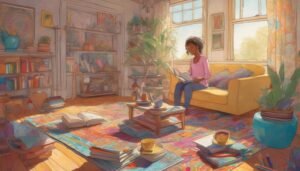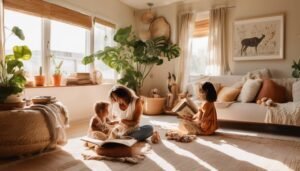Did you know that many common baby products can release harmful toxins into your nursery? It’s crucial to create a safe environment for your little one by choosing non-toxic materials and furnishings. You might be surprised at how easy it is to make healthier choices. Understanding the right paints, furniture, and textiles can significantly impact your baby’s well-being. Let’s explore how to transform your nursery into a low-tox haven.
Key Takeaways
- Choose furniture made from solid wood and ensure it has non-toxic finishes to promote a healthy environment.
- Opt for organic bedding and textiles to minimize exposure to harmful chemicals and enhance comfort.
- Select low-VOC or water-based paints, allowing time for them to air out before nursery use.
- Use safe, natural cleaning products to maintain indoor air quality without introducing harmful toxins.
- Prioritize toys made from natural materials like wood or organic cotton to support safe play and development.
Understanding Toxins in Baby Products
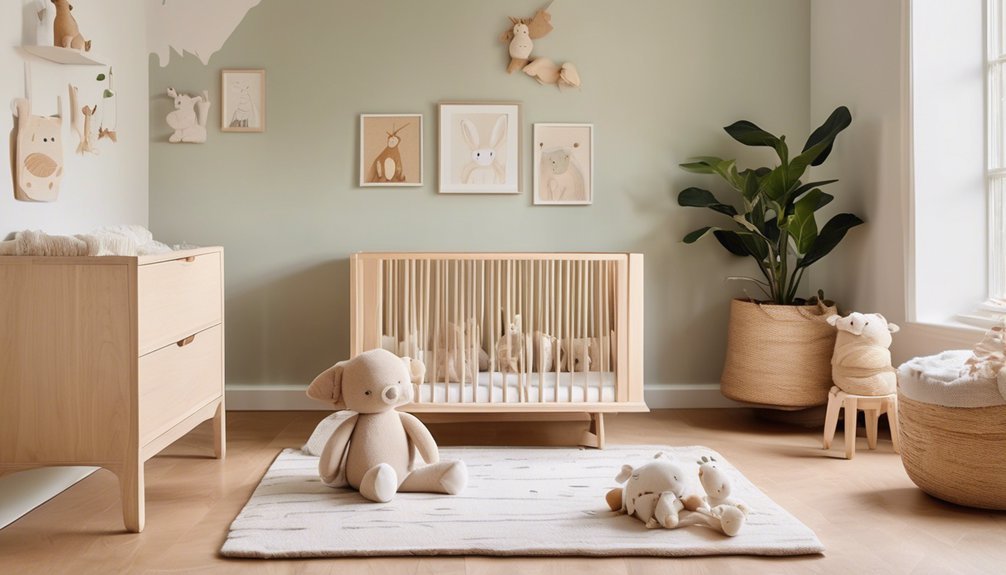
When you prepare your baby’s nursery, it’s crucial to understand the potential toxins lurking in everyday products. Many items you might consider—like crib mattresses, toys, and even bedding—can contain toxic chemicals that could impact your little one’s health.
You’ll want to prioritize product sourcing, choosing brands that openly disclose their materials and safety practices. Look for certifications that confirm products are free from harmful substances like phthalates and formaldehyde.
Don’t hesitate to reach out to manufacturers for clarity; a responsible company will gladly provide this information. Your baby’s well-being is worth the extra effort.
Choosing Non-Toxic Paints
As you create a safe space for your baby, the choice of paint can significantly affect the nursery’s air quality and overall safety.
Opt for non-toxic paint types, such as water-based or low-VOC options, to minimize harmful emissions. These paints often come in a range of beautiful color choices, allowing you to design a serene environment without compromising safety.
Remember to check for certifications like Greenguard or Low-VOC labels, ensuring the paint meets stringent safety standards.
Also, consider painting well in advance, allowing ample time for any lingering odors to dissipate.
Selecting Safe Furniture Materials
Selecting safe furniture materials is crucial for creating a baby nursery that prioritizes health and safety.
You want to ensure your little one’s environment is free from harmful chemicals. Here are three tips to guide your choices:
- Opt for Solid Wood: Choose furniture made from solid wood rather than composite materials, which often contain harmful adhesives.
- Check for Sustainable Sourcing: Look for brands that emphasize sustainable sourcing, ensuring the wood is harvested responsibly.
- Select Non-Toxic Furniture Finishes: Avoid finishes that contain volatile organic compounds (VOCs). Water-based finishes are often a safer choice.
Opting for Organic Bedding and Textiles

Choosing organic bedding and textiles for your baby’s nursery not only promotes a healthier sleeping environment but also supports sustainable practices.
When you opt for organic fabric options, you’re ensuring that your little one isn’t exposed to harmful chemicals often found in conventional textiles.
Look for hypoallergenic materials like organic cotton or bamboo, which are gentle on sensitive skin and reduce the risk of allergies.
These materials aren’t only safe but also breathable, helping to regulate your baby’s body temperature during sleep.
By selecting bedding free from pesticides and synthetic dyes, you’re fostering a nurturing space that prioritizes your child’s well-being.
Creating this sanctuary with organic textiles can truly enhance your nursery’s comfort and safety.
Incorporating Eco-Friendly Flooring Options
While you might be focused on creating a cozy haven for your baby, it’s equally important to consider eco-friendly flooring options that contribute to a healthier environment.
Choosing the right flooring can reduce toxins and support your baby’s well-being. Here are some great options:
- Bamboo flooring: This sustainable choice is durable and naturally antimicrobial, making it perfect for little ones.
- Cork tiles: Soft and warm underfoot, cork tiles are made from renewable resources and provide excellent insulation.
- Natural linoleum: Unlike vinyl, linoleum is biodegradable and made from natural materials, ensuring a low-toxic environment.
Finding Chemical-Free Baby Toys
Creating a nurturing environment goes beyond just flooring; it extends to the toys your baby interacts with as well. When selecting toys, opt for those made from natural materials like wood, organic cotton, or silicone. These options minimize exposure to harmful chemicals often found in plastic toys.
Look for items designed for sensory play, as they stimulate your baby’s senses, aiding in development. Soft textures, gentle sounds, and vibrant colors engage curiosity and encourage exploration. Always check for certifications that ensure safety, and avoid items with small parts that could pose choking hazards.
The Importance of Air Quality
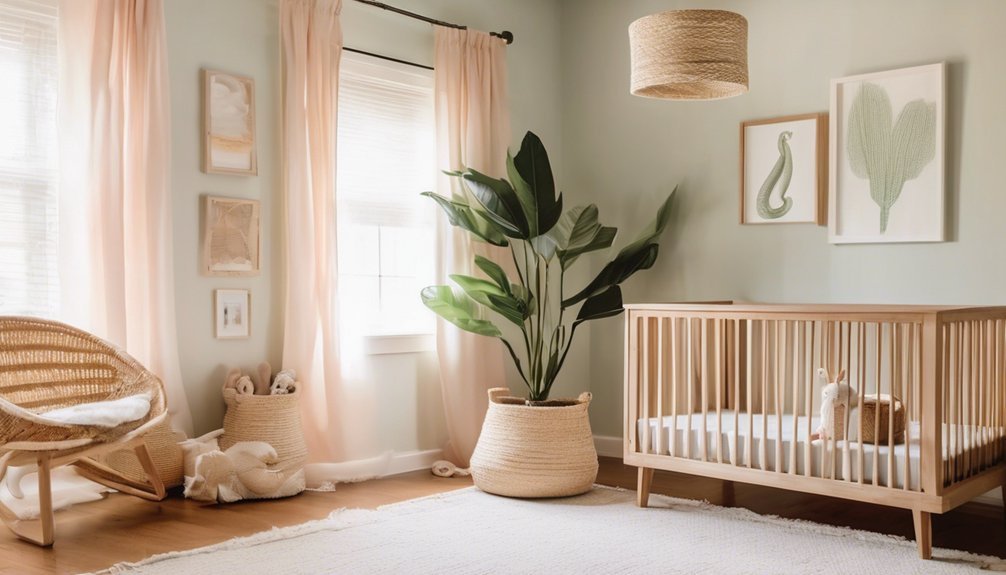
Ensuring good air quality in your baby’s nursery is crucial, as it directly impacts their health and development.
Poor air quality can lead to respiratory issues and affect sleep. Here are some ways to enhance air quality in your little one’s space:
- Implement air purification: Invest in a high-quality air purifier that can filter out allergens and pollutants.
- Use ventilation strategies: Open windows when weather permits to allow fresh air circulation. Consider exhaust fans to remove stale air.
- Choose low-emission products: Opt for furniture and decor made from natural materials to minimize volatile organic compounds (VOCs).
Using Natural Cleaning Products
Many parents overlook the importance of using natural cleaning products in their baby’s nursery, but it’s a vital step in creating a safe environment. Conventional cleaners often contain harsh chemicals that can irritate your baby’s sensitive skin and lungs. By opting for natural disinfectants and DIY cleaners, you can ensure a healthier space for your little one. Here’s a quick comparison of some effective options:
| Natural Option | Conventional Cleaner |
|---|---|
| Vinegar & Water | All-Purpose Spray |
| Baking Soda | Abrasive Cleaners |
| Lemon Juice | Chemical Disinfectants |
| Castile Soap | Scented Surface Wipes |
| Essential Oils | Air Fresheners |
Embracing these alternatives not only protects your baby but also contributes to a more eco-friendly nursery.
Creating a Safe Sleep Environment
While it might seem overwhelming to navigate the guidelines for a safe sleep environment for your baby, taking a few key steps can significantly reduce risks.
Prioritizing safe sleep practices not only fosters a peaceful night for your little one but also brings you peace of mind.
- Use a firm, flat mattress: Ensure it fits snugly in the crib, avoiding gaps that could pose a suffocation hazard.
- Keep the crib clear: Remove pillows, blankets, and toys to minimize the risk of suffocation or entrapment.
- Position your baby on their back: This is the safest sleep position and reduces the likelihood of Sudden Infant Death Syndrome (SIDS).
Minimizing Plastic Use
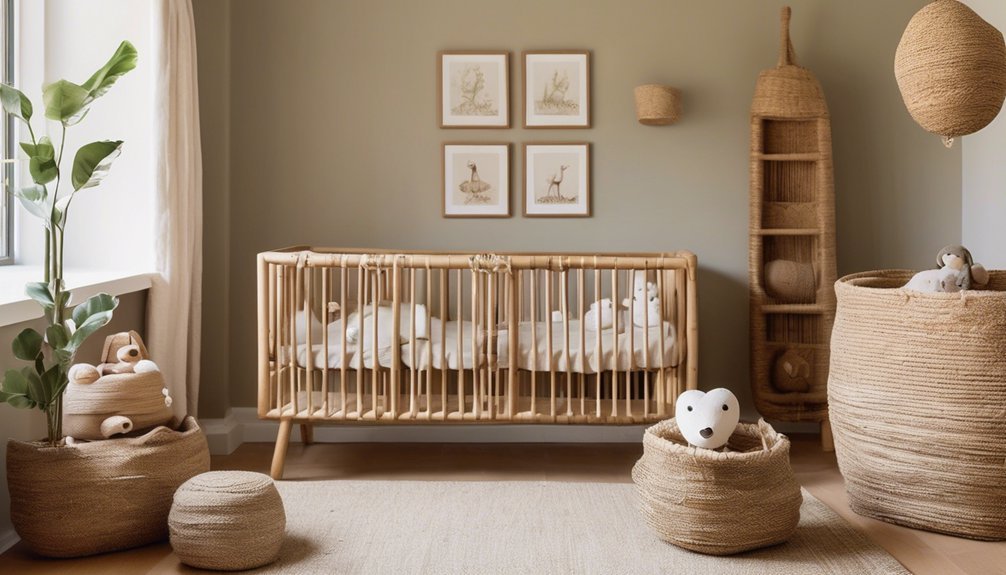
Creating a safe sleep environment is just the beginning of fostering a healthy nursery for your baby. To truly nurture their well-being, consider minimizing plastic use.
Plastics can release harmful chemicals, so reducing plastic in your nursery is vital. Start by opting for sustainable alternatives, like wooden toys, organic cotton bedding, and glass bottles.
Look for furniture crafted from natural materials, ensuring it’s free from toxic finishes. When choosing decor, prioritize items made from metal, ceramic, or fabric, which are safer for your little one.
Embracing these eco-friendly options not only protects your baby but also contributes to a healthier planet. Remember, every small change you make can lead to a safer, more loving environment for your precious child.
Understanding Labels and Certifications
How can you ensure the products you choose for your baby’s nursery are truly safe? Understanding labels and certifications is key.
Look for label transparency that reveals what’s inside each product. This honesty helps you avoid harmful substances that could affect your baby’s health.
Here are three important certifications to consider:
- GREENGUARD Gold: Indicates low chemical emissions, ensuring a healthier indoor air quality.
- OEKO-TEX Standard 100: Confirms textiles are free from harmful substances and safe for baby use.
- CertiPUR-US: Guarantees foam products are made without harmful chemicals.
Resources for Low-Tox Living
As you embark on the journey to create a low-tox baby nursery, having access to reliable resources can make all the difference.
Websites like the Environmental Working Group (EWG) offer valuable insights into reducing toxic exposure, while blogs focused on sustainable practices provide firsthand experiences from other parents.
Look for eco-friendly resources, including certifications that ensure products are free from harmful chemicals. Books on natural parenting can also guide you through the health benefits of non-toxic choices.
Connecting with local communities, like parenting groups focused on low-tox living, can give you support and ideas.
Frequently Asked Questions
How Can I Identify Hidden Toxins in Baby Products?
To identify hidden toxins in baby products, you should practice toxin awareness by carefully reading product labels. Look for harmful chemicals, and choose brands that prioritize safety and transparency to protect your little one.
Are There Specific Brands Known for Low-Tox Baby Items?
Choosing baby products feels like navigating a treasure map. You’ll find eco-friendly brands like Naturepedic and Finn + Emma, known for their commitment to natural materials, ensuring your little one’s environment is safe and nurturing.
Can I Use Second-Hand Furniture in a Low-Tox Nursery?
You can use second-hand furniture, but make sure you conduct safety checks first. Look for non-toxic materials and avoid items with harmful chemicals. Your baby deserves a safe, healthy environment, and you’re doing great by being cautious.
What Are the Best Plants for Improving Nursery Air Quality?
Did you know certain plants can remove up to 87% of toxins in 24 hours? For your nursery, consider air purifying plants like spider plants or peace lilies—they’re nursery-friendly species that enhance air quality beautifully.
How Often Should I Clean to Maintain a Low-Tox Environment?
You should establish a regular cleaning schedule, ideally weekly, to maintain a low-tox environment. Use toxin-free products for dusting and sanitizing, ensuring your space remains healthy and safe for both you and your little one.
Conclusion
Creating a low-tox baby nursery is like crafting a protective cocoon for your little one. Just as a butterfly emerges safe from its chrysalis, a nurturing environment free from harmful chemicals helps your baby thrive. By carefully choosing non-toxic materials and prioritizing air quality, you’re laying the groundwork for their health and happiness. Every choice counts, so embrace this journey with love and intention, knowing you’re giving your child the best start in life.


